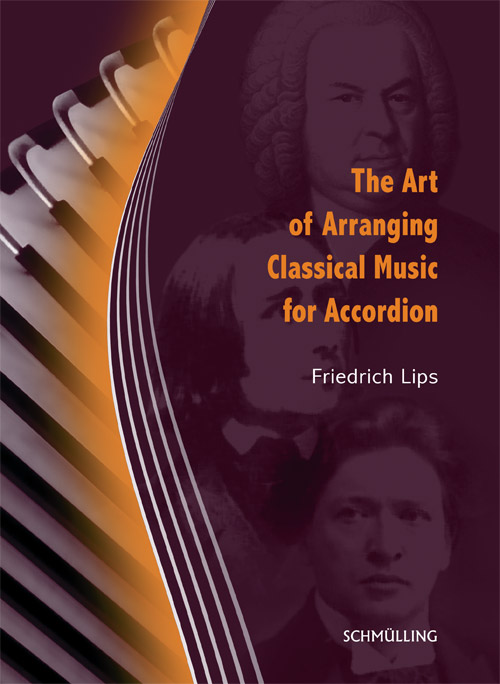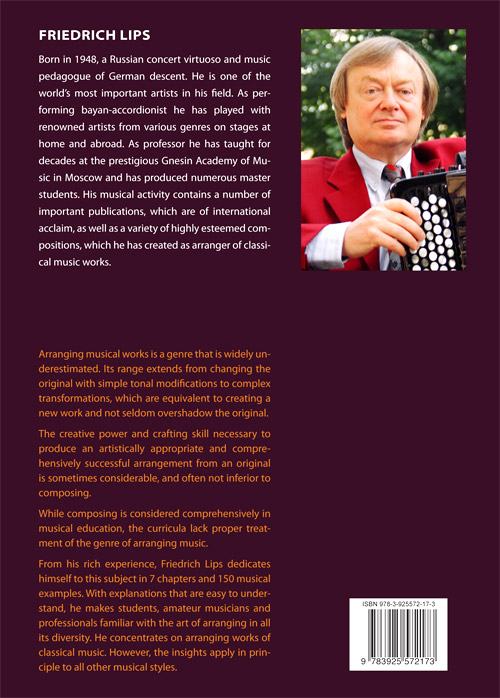 Cover images (from top to bottom): Johann Sebastian Bach, Franz Liszt, Ferruccio Busoni. |
Friedrich Lips
|
Contents |
|
Chapter One The Importance of Arranging Music for the Accordionist s Development Chapter Two Historical Review about the Genre of Arranging Music Chapter Three On the Essence of Arranging Music Chapter Four The Possibilities of Artistic Presentation with the Modern Accordion Tonal range Registration Playing techniques and types of articulation Chapter Five Basic Principles for Arranging Music Chapter Six Arranging Organ Compositions Organ construction, function and history Notation for arranging organ works Transcribing the pedal part Combining and arranging voices Distributing the organ s musical texture Using the registers Polyphony Bellows technique Chapter Seven Arranging Clavier Music Arranging harpsichord compositions Registering harpsichord compositions on the accordion Bellows techniques in transcriptions of harpsichord music Dynamics and articulation Arranging piano compositions Considering the piano s sustain pedal Methods of interpretation Registering piano transcriptions on the accordion Revising the musical texture by using bellows techniques |
| Inside Cover Flap BACH LISZT BUSONI Johann Sebastian Bach (1685 1750) is considered the epitome of a composer genius, having created a plethora of musical works that are among the most important in the history of music. Bach is less well-known as an arranger of compositions, even though he earns the highest merit in further developing this musical art. In his complete oeuvre, which according to the Bach-Werke-Verzeichnis (BWV; Bach Works Catalogue ) comprises a good 1,000 compositions. The arrangements of both his own works as well as foreign pieces account for almost half of his artistic activity. Franz Liszt (1811 – 1886) embodies the universal and outstanding instrumental virtuoso like no one else. This is attributed to his incomparable abilities on the piano as well as his creative talent as an apparently boundless arranger and composer of musical compositions. Especially with the arrangements that he created for himself and the piano in a revolutionary tailor-made way, he could present himself to his audience in a perfect manner. Franz Liszt is regarded as the founder and outstanding master of the transcription genre. Ferruccio Busoni (1866 – 1924) has received less attention in the history of music, although his artistic greatness is equally unique and varied. He combines the innovative creativity of a high-profile composer and an outstanding, intellectual arranger with the phenomenal perfection of a piano virtuoso. Ferruccio Busoni was a multi-faceted and at the same time highly-educated, advanced and worldly-wise artist as well as protagonist of central and far-reaching importance in arranging music. Inside Cover Flap Right: Adaptation, arrangement, editing, paraphrase, transcription are some of the technical terms describing the different variants of transforming original musical works. The range of creative possibilities is just as great as the inventive power of the artist, who makes the change, allows it. This explains why the many terms that musicology uses to verbalize the different forms of appearance are just as vague as they are multifarious. The practice of altering already existing, already created musical works is probably as old as composing itself. Thereby the boundaries between truly new and artistically altered ones are often fluid, because the arranger s artistic design, intellectual freedom and creative imagination cannot be forced into a rationally comprehensible, predefined framework. The necessary amount of imagination for transforming must always be consistent with the required dimensional accuracy and restraint vis- -vis the original or the intentions of its creator. The arrangement of an original is not to be seen as the opposite of it, but as a completely independent creation, which exists beside the original. For this reason, it was Ferruccio Busoni who came to the fundamental appraisal: Man cannot create, but only process what he finds on earth. The profound artistry required for properly changing the original and the mandatory musical expertise must be learned earnestly. Apart from musical-theoretical knowledge and artistic creativity, it is necessary not only to have the ability to grasp the composer s creative thoughts and intentions underlying the original work but also to possess special familiarity with the characterstics of the instruments in question. Although in the history of music mainly the creators of original works survive and receive wide attention, outstanding personalities can still be found who have made a name for themselves as arrangers. Three classics have brought the genre to such excellent mastery ... Further Information: Edited by: Prof. Ulrich Schm lling Translation: Willoughby Ann Walshe Expert advice: Dr. Nikolas Fehr, Vitali Neifert Typesetting of musical scores: Lina Klimkaite ( ), Arunas Raziunas Proofreading: Dr. Nikolas Fehr, Peter Gondolf Complete production: Musikverlag Ulrich Schm lling, Kamen, Germany. |
| "Lips CD's For Sale |
| Normal Price € 42,50 or the US $ equivalent plus postage. Order by credit card, with the secure server Paypal system. Euro Order US$ Order |
|
Copyright 2018 MusicForAccordion.com.
All rights reserved
|
